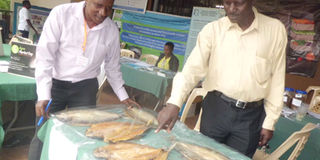Easy ways to preserve fish

Nasser Kasozi (L) displays pebbly fish during the fish symposium in Kampala recently. Photo by Lominda Afedraru
What you need to know:
- Nasser Kasozi of Abi Zonal Agricultural Research and Development Institute (Abi ZARDI) in Arua has devised new scientific technology of value addition in the processing and packaging of pebbly fish commonly known as Angara, writes Lominda Afedraru.
Uganda is richly endowed with natural water bodies and fisheries play a very important role as a basis for subsistence and commercial livelihood of a good number of people.
Lake Victoria is the largest and economically most significant of the national fisheries contribution.
However other large lakes, including George, Edward, Albert and Kyoga along with the River Nile and a great variety of swamps and streams also contribute substantially to the annual national catch.
While most stakeholders in the sector will concentrate on promoting fish species like Tilapia and Nile perch as the major farmed species, scientists at Abi Zonal Agricultural Research and Development Institute (Abi ZARDI) in Arua are supporting fish catchment of pebbly fish species locally known as angara and Brycinus nurse known as onangnang commonly found in Lake Albert.
Processing and packaging
The key point of emphasis is adoption of proper processing and packaging of the two fish species for high food value safety and standards to maintain its taste, colour, smell, texture and nutritional value.
Nasser Kasozi, in charge of fish breeding programme at Abi ZARDI says it is important for fishermen to ensure they sun dry angara for four to five days and on erased racks under continuous sunshine.
According to him, most processed angara sold in open markets is dried for two days and in sandy places leading to poor texture.
“Since the fish contains a lot of fat, if not properly dried it will end up forming liquid oxidation resulting to unflavoured fish,” he says. Most farmers use fine salt for drying but it is advisable to use coarse salt particles which can be absorbed well in its flesh.
Kasozi explains that the presence of foodborne pathogens in a fish product is a function of the harvest environment, sanitary conditions, and practices associated with equipment and personnel in the processing environment.
The handling of fish products during processing involves a risk of contamination by pathogenic bacteria such as Vibrio parahaemolyticus and Staphylococcus aureus causing foodborne human intoxication.
There is substantial evidence that fish and seafood are high on the list of foods associated with outbreaks of food borne diseases around the world.
In a study conducted by Kasozi to estimate the presence of microbiological and chemical characteristics of traditionally dry-salted fish product of pebbly fish, a total of 40 random dry fish samples were collected from Arua, Nebbi, Packwach and Panyimur markets.
The moisture content of dry-salted fish collected from different markets was in the range of 37 percent to 41 percent.
Results from microbial analysis indicated that S. aureus bacteria was the most dominant in dry-salted fish sold in all markets with Nebbi market having the highest counts followed by Panyimur, Packwach and Arua.
The study revealed that most of fish sold in these markets has bacterial counts beyond the maximum tolerable limits recommended by Uganda National Bureau of Standards.
Storage
Fish farmers are encouraged to control storage temperature and ensure proper cooking procedure to reduce the microorganisms.
Kasozi and team have now embarked on training farmers from West Nile in proper drying and packaging methods of pebbly fish and Brycinus nurse.
The team is discouraging farmers from keeping salted Pebbly fish in sacks but shoulder rather pack each in a box.
The Naro team has come up with a box package for keeping well dried pebbly fish which is sold at Shs25, 000. Each box contains one dried fish which can last up to six months without getting spoilt.
“It is important to get fresh fish from the lake which must be washed in clean water, cut and separated it in the middle. Coarse salt should be added on the surface. Leave it to dry under constant sunshine for four to five days and then pack each in the boxes,” he advises.




